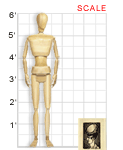From the collection of:
Clara M. Eagle Gallery, Murray State University || VAM Home
Georges Rouault (French, 1871-1958)
LES REINCARNATIONS, 1929
Etching; 8" X 11"
1985.002
Clara M. Eagle Gallery, Murray State University
This etching demonstrates Georges Rouault’s use of bold, dark outlines in his work, a characteristic attributed to an influence of the artist’s training in the art of stained glass as a teenager.
About the Artist
Georges Rouault was born in Paris, France, in 1871. In 1885, at the age of 14, he became an apprentice to a glass painter and restorer. In addition to studying at the glass studio, Rouault took classes at the École des Arts Decoratifs and studied painting at the Louvre. In 1891, he enrolled in the École des Beaux Arts, where he became a favored pupil of Gustave Moreau. The two became so closely acquainted that Rouault was appointed curator of the Moreau Museum in Paris after Moreau’s death in 1898.
“For me, painting is a way to forget life. It is a cry in the night, a strangled laugh.”
In 1905, Rouault exhibited his work with the Fauves, although he was never directly linked with the movement. Over the years, his work became increasingly expressionistic. In 1907, he began a series of works focusing primarily on clowns and prostitutes, construed by many as a social and moral criticism of contemporary society.
Beginning in 1917, Rouault focused nearly all of his artistic energy on printmaking, looking more and more to religion for inspiration. Upset by their lack of perfection, Rouault burned more than 300 of his artworks sometime around 1947. From then until his death in 1958, he worked fervently to execute works with which he was satisfied. Rouault said, “For me, painting is a way to forget life. It is a cry in the night, a strangled laugh.”
Classroom Ideas
Discussion: Art critics often compare Rouault’s works to stained glass. Do you see any evidence for such a comparison in Les Reincarnations? The title translates in English simply as “reincarnations,” a word defined as the rebirth of a soul into a new body or form. What might this title mean in regard to the image?
Activity: Choose a partner and practice drawing him or her in profile using vine charcoal and a large sheet of drawing paper. Do you think it is easier to draw someone in profile or in a full head-on view? Why? Why might an artist choose to draw someone in profile rather than head-on?
Links
Some places to see other works by Rouault online:
- Fine Arts Museums of San Francisco
[search.famsf.org:8080/search.shtml?keywords=georges+rouault] - Museum of Modern Art
[www.moma.org/collection/browse_results.php?criteria=O:AD:E:5053&page_number=1&template_id=6&sort_order=1] - Minneapolis Institute of Art
[www.artsmia.org/collection/search.cfm?start=1&query=Rouault] - Cincinnati Art Museum
[cincinnatiartmuseum.org/greatart/provenance_listofworks_r.shtml] - University of Michigan
[www.si.umich.edu/Art_History/demoarea/htdocs/browser/Artist/Artist__R/ROUAULT__GEORGES_Georges_Rouault/]
Still more online resources are listed in the Artcyclopedia.
[www.artcyclopedia.com/artists/rouault_georges.html]
For a closer examination of Rouault’s life and motivation, plus a list of images and suggested readings, consult the Artchive.
[artchive.com/artchive/R/roualt.html]

